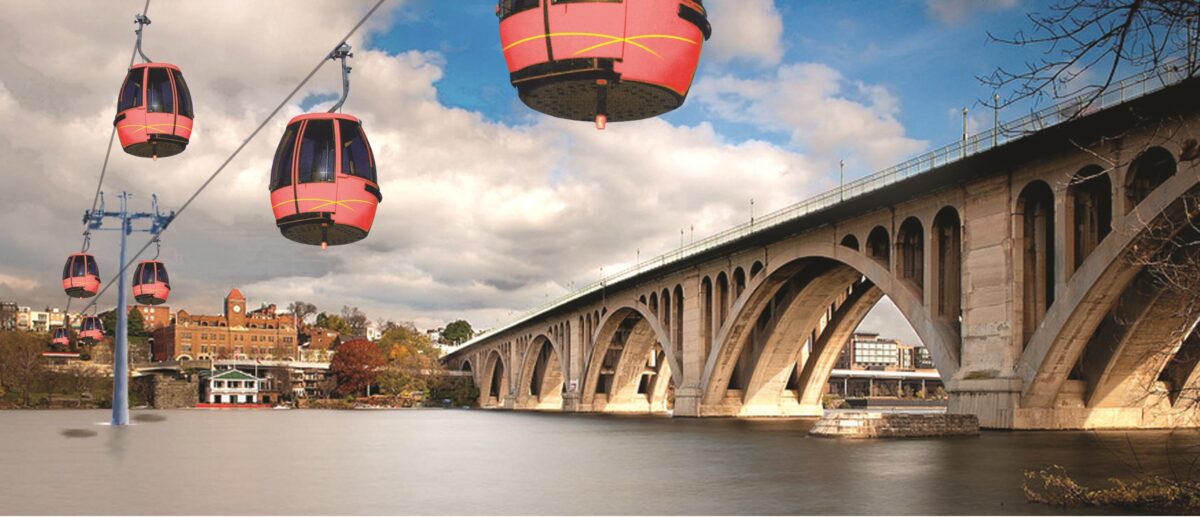Georgetown to Metrorail Transit Enhancement Study
Introduction & Background
In 2021, the Federal City Council, together with the District Department of Transportation (DDOT), Georgetown Business Improvement District (BID), and National Capital Planning Commission (NCPC), initiated a study to identify potential transit improvements to connect Georgetown to the Metrorail system.
The goal of the Georgetown Transit Enhancement to Metrorail Project was to identify a preliminary range of alternatives that would provide workers, students, residents and visitors with a reliable, frequent, safe, and sustainable non-auto connection between Georgetown and the Metrorail system.

Study Outcomes
- A preliminary range of alternatives to provide direct, frequent, rapid transit between the Metrorail System and Georgetown were identified.
- Preliminary, high-value input was received from the agency stakeholders and nearly 4,000 members of the public related to the Purpose and Need, as well as the preliminary alternatives the study identified.
- Strong technical analysis and organization of deliverables set the stage for formal initiation of review process under the National Environmental Policy Act (NEPA), as applicable.
- Supports parallel, related work being led by DDOT, including the DDOT Georgetown Access and Circulation Study and the DDOT Bus Priority Alternatives Analysis, both happening this year.
Study Conclusions
There is a Need for Enhanced Transit Access to and from Georgetown
Both the quantitative technical analysis conducted by VHB Metro DC, as well as the qualitative, agency stakeholder and public engagement components of the study validate the unmet demand for frequent, reliable, competitive transit access to and from Georgetown. The study’s combined bus and Gondola alternatives created a strong foundation for public discourse around alternatives and tradeoffs.
Two Highly Beneficial Bus Priority Alternatives
Two bus alternatives emerged as highly beneficial to two of the three study nodes. The initial public response to dedicated bus infrastructure was as strong, if not stronger than the reaction to a Gondola alternative.
Gondola Transit Alternative Remains Attractive and Worthy of Additional Analysis
Study analysis indicated that no surface transit solutions at the Key Bridge and M St. bottleneck offer access improvements comparable to the aerial gondola alternative. Given historic federal infrastructure investments like this in the Bipartisan Infrastructure Law and minimal surface impact trade-offs, the gondola alternative remains a viable and appealing alternative.
Next Steps
Preparation for NEPA and Environmental Impact Study
Further development of the bus priority and aerial gondola alternatives is required for any Phase 1 alternatives to progress. Environmental and historical impact analysis is necessary for the gondola alternative’s advancement under NEPA requirements. Bus priority alternatives need additional analysis and development, particularly those impacting federal properties or viewsheds.
Combining Alternatives for Coherent Project Understanding
Stakeholders and the public requested the analysis of combining the bus and aerial gondola alternatives to assess the impact of implementing multiple alternatives as a single cohesive project.
Current Funding and Parallel DDOT Efforts
No dedicated funding exists at present to advance any of the alternatives for further development. DDOT is concurrently progressing with efforts to enhance access and safety in Georgetown:
- Georgetown Access and Circulation Study (FY23): This broad DDOT study will consider neighborhood-related alternatives and leverage the Transit Enhancement Study without analyzing bus or gondola alternatives. March 2023- December 2024
- DDOT Bus Transit Alternatives (FY24): Includes traffic and feasibility analysis, conceptual design and detailed transit operational analysis for dedicated bus infrastructure. October 2023-Summer 2024

